One of the two masts at the research station reaches 150 metres straight up in the air from the dense forest. A staff member climbs the mast every other week. Credit: Adam Kristensson
Twenty years of measurements are only the beginning. Long-term measurements over several decades are crucial to enable predictions of how airborne particles affect the future climate, according to Lund University researcher Erik Ahlberg.
"Long-term measurements are important to prove that various climate initiatives actually work. Say we were to close all coal power plants today—with the our time-series we can clearly see what difference this made in the long run. The measurements constitute proof that cannot be replaced by other types of research data."
Data predicts the future climate
Erik Ahlberg works at the Nuclear Physics division at Lund University and is active in the strategic research area MERGE—ModElling the Regional and Global Earth system. He works at the Hyltemossa research station in Söderåsen. Two masts, respectively 30 and 150 meters high, enable researchers to measure the presence of airborne particles and greenhouse gases that flow in from elsewhere in Europe. There are similar research stations in other parts of Europe, all reporting data to two networks tasked with creating a comprehensive picture of levels of greenhouse gases and airborne particles over time. The data can be used in models to predict the future climate.
Tricky to measure
Erik Ahlberg explains that airborne particles, or aerosols as they are also known, have a major impact on the climate—something which is sometimes forgotten in the current strong focus on reducing greenhouse gas emissions.
Aerosols are tiny particles that are finely distributed in a gas; they can be solid or liquid. The aerosol includes both the particles and the gas. Aerosol particles are emitted from various types of combustion, such as from traffic and heavy industry. However, aerosols also form naturally, for example from the gases emitted by vegetation, or through saltwater droplets that dry out. Aerosol particles are shorter-lived than greenhouse gases and disappear from the atmosphere after only a week or so.
"Generally, you can say that aerosol particles contribute to cooling the climate as they affect solar radiation and contribute to cloud formation. However, this is not true of all particles. Soot particles, for example, which forms in combustion, make the climate warmer."
The man in the woods, Janne Rinne, professor of physical geography, working with other researchers to gather data for European climate research from the Hyltemossa research station. Credit: Kennet Ruona
The Hyltemossa research station also measures particle size, a factor that is at least as important as their concen- tration. Larger particles generally affect radiation more, but also have a much shorter life in the atmosphere.
"It is tricky to measure aerosol particles. There is still a great deal of uncertainty, not least concerning how their lifespan affects temperature and cloud formation. It is therefore important to take measurements in many different locations in Europe, not only at Söderåsen."
The aerosol particle paradox
The Hyltemossa measurements show that there have been fewer particles originating from the European mainland over the past 20 years, which is due to industries and motor vehicle fleets becoming cleaner. This is positive, as improved air quality reduces the numberof deaths attributable to air pollution. However, over the long term, a major reduction in aerosols could make the climate warmer, explains Erik Ahlberg.
"Paradoxically enough, aerosols can actually be good for the climate as they have a cooling effect, even though they are negative for human health. In cities, we don't want high levels of aerosol particles, but in remote locations where there are few people it is perhaps notas bad. However, when it comes to soot particles, which are harmful for both the environment and human health, getting rid of them is a win-win."
Moreover, aerosol particles and greenhouse gases are not decreasing at the same rate, Erik continues. For example, catalytic converters in cars reduce the number of particles in the atmosphere but do not remove carbon dioxide. When industries move out of Europe, their emissions of aerosol particles and greenhouse gases move with them to other parts of the world. But the greenhouse gases remain in the atmosphere and are spread evenly all around the planet in time, whereas the aerosol particles, which have a shorter lifespan, don't reach Europe.
The answer to how a potential reduction in aerosol particles could affect the climate and how aerosols interact with greenhouse gases is to be found once again in the long-term measurements, says Erik Ahlberg.
"Measuring over time is the absolutely most important contribution we can make with our research at Hyltemossa. Without this type of measurement, we cannot say anything about how climate models work, neither backwards nor forwards. I see Hyltemossa as an important piece of the puzzle which, together with other research stations, contributes to better models, more knowledge and opportunities for other researchers to use the data," concludes Erik Ahlberg.
Provided by Lund University

























